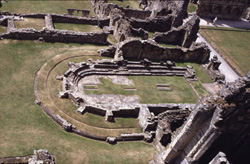 |
 |
 |
 |
 |
 |
 |
|
The chapter meeting (4/4) After the necessary disciplinary measures had been taken, business matters were discussed: announcements were made, letters read out, officials appointed and novices or lay-brothers professed. On certain feast days a sermon was given and on such occasions the lay-brothers might join the monks in the chapter-house, but if there was a shortage of space they were expected to listen at the door.(9) Rievaulx’s chapter-house may have been especially designed to accommodate the lay-brothers on such occasions, for it had side aisles with additional seating. At the close of the chapter meeting the monks stood facing eastwards for the recitation of Psalm 129 (De Profundis) and prayers.(10)
Notable visitors, such as royalty and prelates, were received by the community in the chapter-house, where they would receive the blessing and hear a reading, and might thereafter address the community.(11) Those conducting a visitation of the abbey would have read out their injunctions in the chapter-house, benefactors might formalise their grants here or be received into the confraternity of the house, and it was in the chapter-house at Rievaulx – as at other religious houses in England and Wales – that the community gathered for the last time and surrendered its abbey to Henry VIII’s commissioners. |
